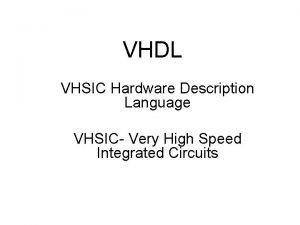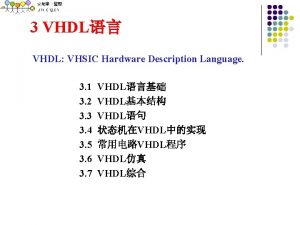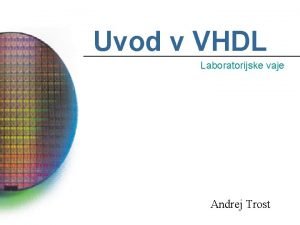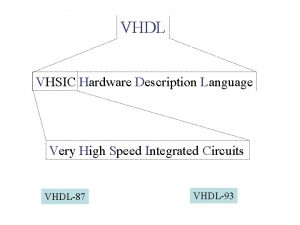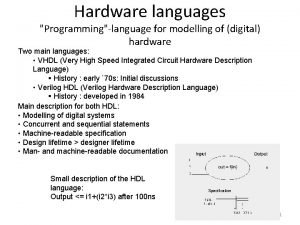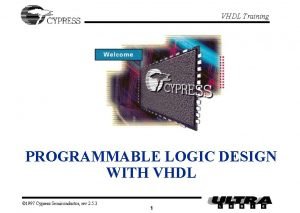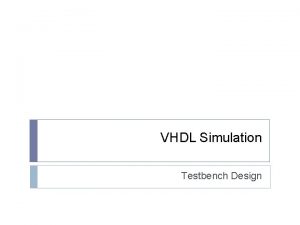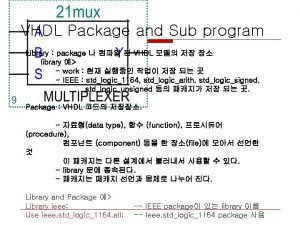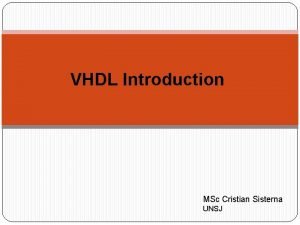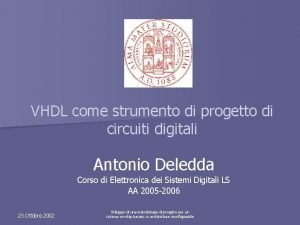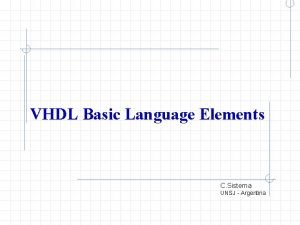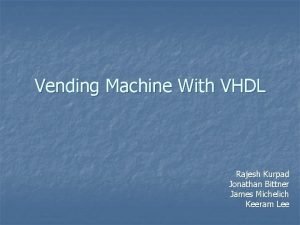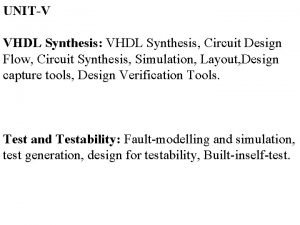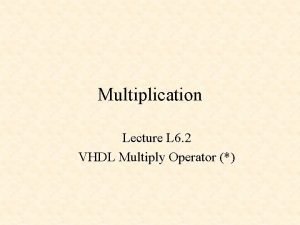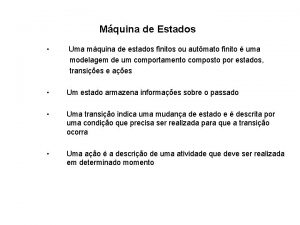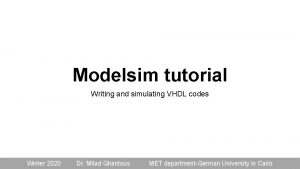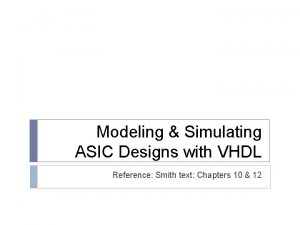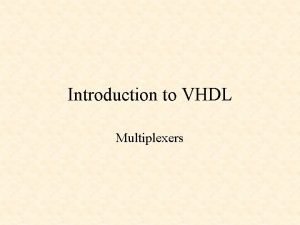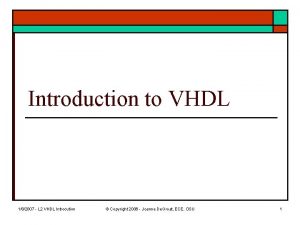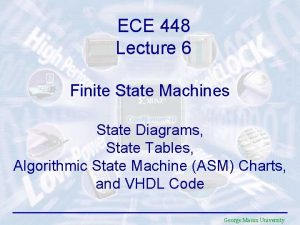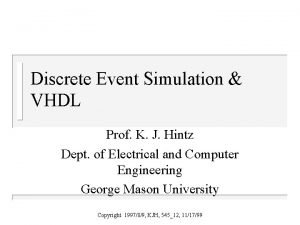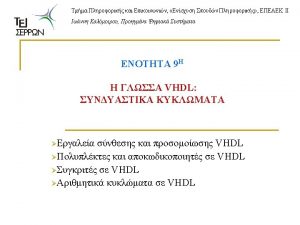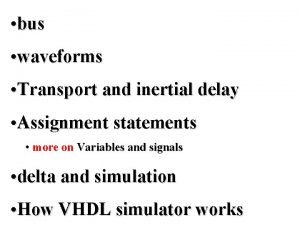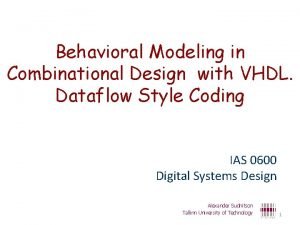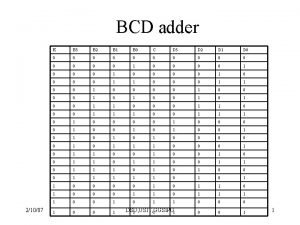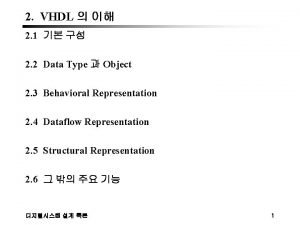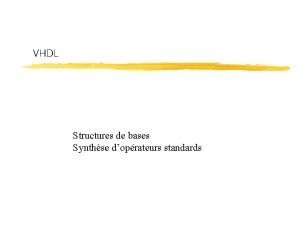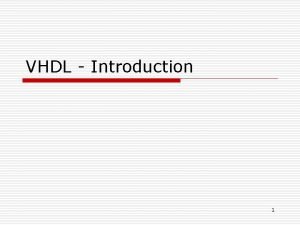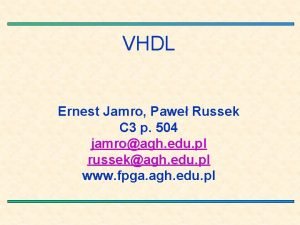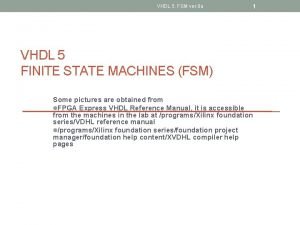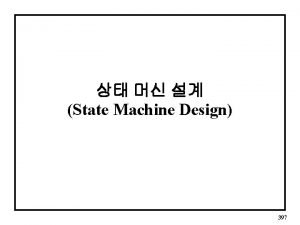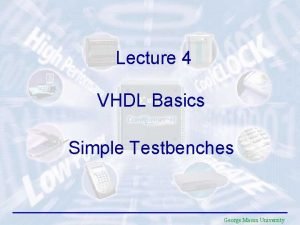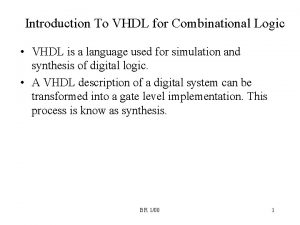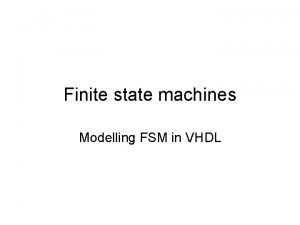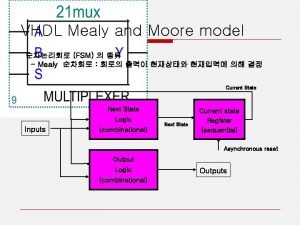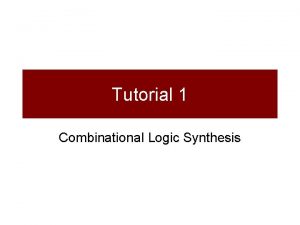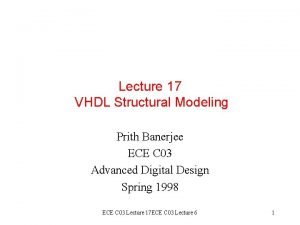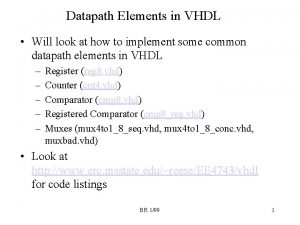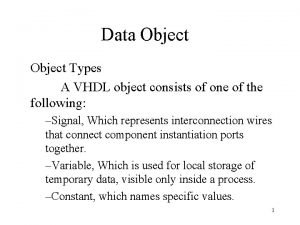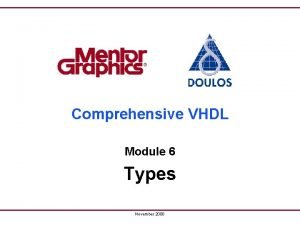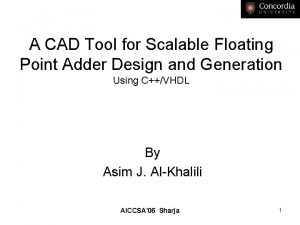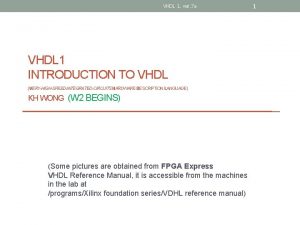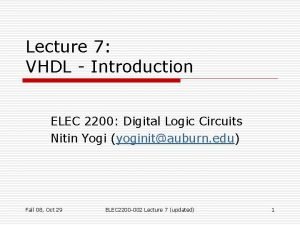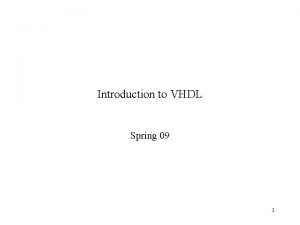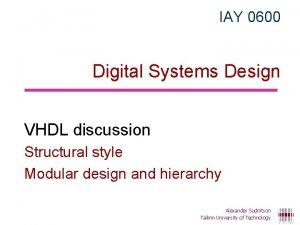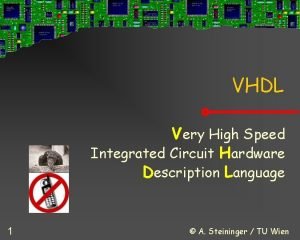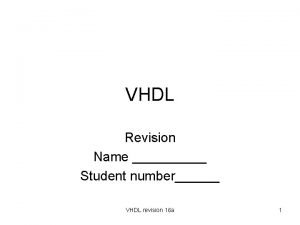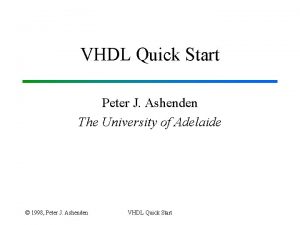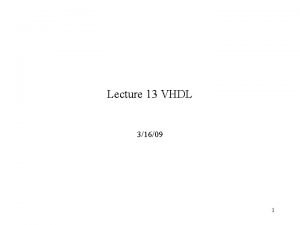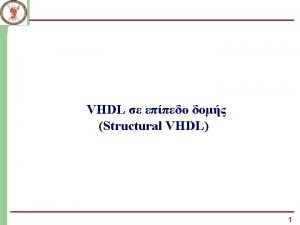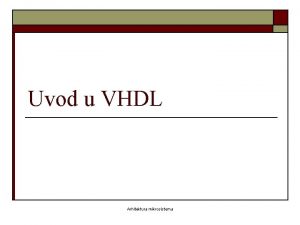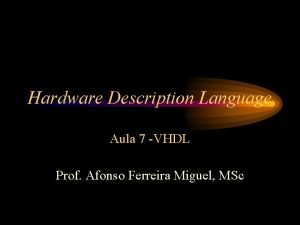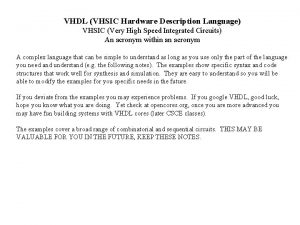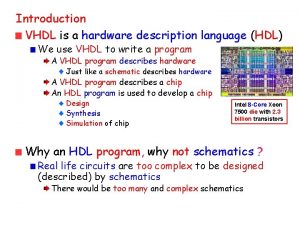VHDL Hardware Description Language GUIDELINES n How to






































![Sequential statements (1) process [process_name: ] PROCESS (sensitivity list) BEGIN sequential statements END PROCESS Sequential statements (1) process [process_name: ] PROCESS (sensitivity list) BEGIN sequential statements END PROCESS](https://slidetodoc.com/presentation_image_h/2e63da5b23a2767091cced57da40cfb8/image-39.jpg)








![for loop statement – shift register [label]: for identifier in range loop statements end for loop statement – shift register [label]: for identifier in range loop statements end](https://slidetodoc.com/presentation_image_h/2e63da5b23a2767091cced57da40cfb8/image-48.jpg)








































- Slides: 88

VHDL Hardware Description Language

GUIDELINES n How to write HDL code:

GUIDELINES n How NOT to write HDL code:

Think Hardware NOT Software n Poorly written VHDL code will either be: – Unsynthesizable – Functionally incorrect – Lead to poor performance/area/power results

VHDL code basic structure n Entity (I/O and generic declaration) n Architecture structural (structure description) rtl (register transfer level description) behavioral (high-level description)

Entity declaration ENTITY entity_name IS PORT (port_name_1 : port_type_1; port_name_2: port _type_2; . . . port_name_n: port_type_n); END entity_name;

Port types n PORT DIRECTION - IN -OUT -INOUT n SIGNAL TYPE – – BIT_VECTOR(WIDTH -1 DOWNTO 0) STD_LOGIC_VECTOR(WIDTH -1 DOWNTO 0)

Entity declaration example (1/2) ENTITY and_gate IS PORT (i 1: IN BIT; i 2: IN BIT; O: OUT BIT); END and_gate;

Entity declaration example (2/2) Library ieee; Use ieee. std_logic_1164. all; ENTITY adder IS PORT (i 1: IN STD_LOGIC_VECTOR(3 DOWNTO 0); i 2: IN STD_LOGIC_VECTOR(3 DOWNTO 0); sum: OUT STD_LOGIC_VECTOR(3 DOWNTO 0); carry: OUT STD_LOGIC); END adder;

Example

Architecture declaration ARCHITECTURE architecture_name OF entity_name IS component declaration; signal declaration; BEGIN component instantiation sequential statements (processes) concurrent statements END [architecture_name];

Component declaration COMPONENT component_name PORT (port_name_1 : port_type_1; port_name_2: port _type_2; . . . port_name_n: port_type_n); END COMPONENT;

Component declaration example COMPONENT and_gate PORT (i 1: IN BIT; i 2: IN BIT; O: OUT BIT); END COMPONENT;

Signal declaration SIGNAL signal_name : signal_type; Examples SIGNAL data_bus: std_logic_vector(7 downto 0); SIGNAL clock: std_logic; SIGNAL count : bit_vector(5 downto 0);

Component instantiation (nominal) Label: component_name PORT MAP( port_name 1 => signal_name 1, port_name 2 => signal_name 2, … port_name. N => signal_name. N);

Example U_adder: adder PORT MAP(i 1 => add 1, i 2 => add 2, sum => s, carry => c);

Component instantiation (positional) Label: component_name PORT MAP( signal_name 1, signal_name 2, … signal_name. N);

Example U_adder: adder PORT MAP(add 1, add 2, s, c);

Structural description example (1/2) ENTITY gates IS PORT (i 0, i 1, i 2, i 3: std_logic; o: out std_logic); END gates; ARCHITECTURE str of gates IS COMPONENT and_gate PORT (i 1, i 2: in std_logic; o: out std_logic); END COMPONENT; SIGNAL s 1, s 2: std_logic; BEGIN

Structural description example (2/2) U_and 1: and_gate PORT MAP(i 1 => i 0, i 2 => i 1, o => s 1); U_and 2: and_gate PORT MAP(i 1 => i 2, i 2 => i 3, o => s 2); U_and 3: and_gate PORT MAP(i 1 => s 1, i 2 => s 2, o => o); END;

VHDL operators • Arithmetic +, - , *, /, abs, rem, mod, ** • Synthesizable Non-synthesizable Logical AND, OR, NOT, NAND, NOR, XNOR Relational =, /=, <, >, <=, >= •

Signal assignment signal_name <= signal_value; Examples signal a: std_logic; signal b: std_logic_vector(6 downto 0); signal c: std_logic_vector(3 downto 0); signal d: std_logic_vector(2 downto 0); Correct Incorrect a <= ‘ 1’; a <= “ 01”; b <= “ 0101001”; b <= ‘ 0’; b(1) <= ‘ 0’; c <= (others => ‘ 0’); c <= ‘ 0000’; d <= (1 => ‘ 0’, others => ’ 1’); d <= b & c; b <= c & d; b(3 downto 1) <= d(1 downto 0); b(5 downto 3) <= d;

The “after” clause Used to assignals with delay, modeling circuit behaviour n a <= d after 5 ns; -- 5 ns wire delay n b <= a and c after 20 ns; -- 20 ns gate delay Not synthesizable, is ignored by synthesis tools Useful in testbenches for creating input signal waveforms n clk <= not clk after 20 ns; -- 40 ns clock period n rst_n <= ‘ 0’, ‘ 1’ after 210 ns;

Concurrent statements – delta time b <= not a; (a = ‘ 1’, b = ‘ 1’, cc==‘ 0’) cc <= <= aa xor b; b; Time 0 δ 2δ aa 1 1 1 bb 1 0 0 cc 0 0 1

Concurrent statements n Multiple driver error c <= a AND b; …. c <= d OR e;

Combinational circuit description ENTITY gates is port (a: in std_logic; d: out std_logic); end gates; Architecture rtl of gates is signal b: std_logic; begin b <= not a; d <= c xor b; --d<=c xor (not a); end rtl;

GENERATE STATEMENTS (concurrent only) n Used to generate multiple instances of a component in homogeneous architectures Z_Gen: For i in 0 to 7 generate z(i) <= x(i) AND y(i+8); end generate;

Generate example (1/2) ENTITY cell_array IS PORT (i: in std_logic_vector(63 downto 0); o: out std_logic_vector(63 downto 0) ); END ENTITY cell_array; ARCHITECTURE str OF cell_array IS COMPONENT cell PORT (i_north: in std_logic; i_west: in std_logic; i_east: in std_logic; o_east: out std_logic; o_west: out std_logic; o_south: out std_logic ); end component; signal west: std_logic_vector(62 downto 0); signal east: std_logic_vector(62 downto 0); BEGIN

Generate example (2/2) U_cell_0: cell PORT MAP (i_north => i(0), i_west => '0', i_east => west(0), o_east => east(0), o_west => open, o_south => o(0) ); U_cell_63: cell PORT MAP (i_north => i(63), i_west => east(62), i_east => '0', o_east => open, o_west => west(62), o_south => o(63) ); U_top_gen: for i in 1 to 62 generate U_cell_i: cell PORT MAP (i_north => i(i), i_west => east(i-1), i_east => west(i), o_east => east(i), o_west => west(i-1), o_south => o(i) ); end generate; end;

Generate example 2 (1/5) ENTITY cell_array IS PORT (i: in std_logic_vector(3 downto 0); o: out std_logic_vector(3 downto 0) ); END ENTITY cell_array; -ARCHITECTURE str OF cell_array IS COMPONENT cell PORT (i_north: in std_logic; i_west: in std_logic; i_east: in std_logic; o_east: out std_logic; o_west: out std_logic; o_south: out std_logic ); end component; type sig_array is array (3 downto 0) of std_logic_vector(3 downto 0); type sig_array 2 is array (2 downto 0) of std_logic_vector(3 downto 0); signal south: sig_array 2; signal west: sig_array; signal east: sig_array;

Generate example 2 (2/5) BEGIN U_cell_0_0: cell PORT MAP (i_north => i(0), i_west => '0', i_east => west(0)(0), o_east => east(0)(0), o_west => open, o_south => south(0)(0) ); U_cell_0_3: cell PORT MAP (i_north => i(3), i_west => west(0)(3), i_east => '0', o_east => east(0)(3), o_west => west(0)(3), o_south => south(0)(3) ); U_cell_3_0: cell PORT MAP (i_north => north(2)(0), i_west => '0', i_east => west(3)(0), o_east => east(3)(0), o_west => open, o_south => o(0) );

Generate example 2 (3/5) U_cell_3_3: cell PORT MAP (i_north => north(2)(3), i_west => west(3)(3), i_east => '0', o_east => open, o_west => west(3)(3), o_south => o(3) ); U_top_gen: for i in 1 to 2 generate U_cell_i_0: cell PORT MAP (i_north => i(i), i_west => east(i-1)(0), i_east => west(i)(0), o_east => east(i)(0), o_west => west(i-1)(0), o_south => south(i)(0) ); end generate; U_bottom_gen: for i in 1 to 2 generate U_cell_i_3: cell PORT MAP (i_north => south(i)(2), i_west => east(i-1)(3), i_east => west(i)(3), o_east => east(i)(3), o_west => west(i-1)(3), o_south => o(i) );

Generate example 2 (4/5) U_left_gen: for i in 1 to 2 generate U_cell_0_i: cell PORT MAP (i_north => south(0)(i), i_west => '0', i_east => west(0)(i), o_east => east(0)(i), o_west => open, o_south => south(0)(i) ); end generate; U_right_gen: for i in 1 to 2 generate U_cell_3_i: cell PORT MAP (i_north => south(2)(i), i_west => east(3)(i-1), i_east => '0', o_east => east(3)(i), o_west => west(3)(i-1), o_south => south(3)(i) ); end generate;

Generate example 2 (5/5) U_inner_gen_x: for i in 1 to 2 generate U_inner_gen_y: for j in 1 to 2 generate U_cell_i_j: cell PORT MAP (i_north => south(i-1)(j), i_west => east(i)(j-1), i_east => west(i)(j), o_east => east(i)(j), o_west => west(i)(j-1), o_south => south(i)(j) ); end generate; END ARCHITECTURE str;

Arithmetic unit description Library ieee; Use ieee. std_logic_1164. all; Use ieee. std_logic_unsigned. all; ENTITY add 1 is port (a, b: in std_logic; cin: in std_logic; sum: out std_logic; cout: out std_logic); end add 1; ARCHITECTURE rtl of add 1 is Signal s: std_logic_vector(1 downto 0); begin s <= (‘ 0’ & a) + b + cin; sum <= s(0); cout <= s(1); end;

Example Describe a 5 -bit multiplier in VHDL.

When statement (concurrent)– describing MUXs Port/signal <= value 1 WHEN condition 1 [ELSE value 2 when condition 2 …] ELSE value. N; ENTITY mux IS PORT (i 0: in std_logic; i 1: in std_logic; s: in std_logic; o: out std_logic); END mux; ARCHITECTURE rtl OF mux IS BEGIN o <= i 0 when s = ‘ 0’ else i 1; END RTL;

with statement (concurrent)– describing MUXs WITH signal SELECT port/signal <= expression 1 WHEN value 1, expression 2 WHEN value 2, … expression. N WHEN OTHERS; ENTITY mux IS PORT (i 0: in std_logic; i 1: in std_logic; s: in std_logic; o: out std_logic); END mux; ARCHITECTURE rtl OF mux IS BEGIN WITH s SELECT o <= i 0 WHEN ‘ 0’, i 1 WHEN OTHERS; END rtl;
![Sequential statements 1 process processname PROCESS sensitivity list BEGIN sequential statements END PROCESS Sequential statements (1) process [process_name: ] PROCESS (sensitivity list) BEGIN sequential statements END PROCESS](https://slidetodoc.com/presentation_image_h/2e63da5b23a2767091cced57da40cfb8/image-39.jpg)
Sequential statements (1) process [process_name: ] PROCESS (sensitivity list) BEGIN sequential statements END PROCESS [process_name];

COMBINATIONAL PROCESS(a, b, c) BEGIN d <= (a AND b) OR c; END PROCESS; ALL input signals must be in sensitivity list or latches will be produced!

If statement (sequential)– describing MUXs If condition 1 then signal 1 <= value 1; signal 2 <= value 2; elsif condition 2 then signal 1 <= value 3; signal 2 <= value 4; … [ELSE signal 1 <= valuen-1; signal 2 <= valuen; ] end if; ENTITY mux IS PORT (i 0: in std_logic; i 1: in std_logic; s: in std_logic; o: out std_logic); END mux; ARCHITECTURE rtl OF mux IS BEGIN process(i 0, i 1, s) BEGIN If s = ‘ 0’ then o <= i 0; else o <= i 1; end if; end process; END rtl;

CASE statement (sequential)– describing MUXs CASE expression IS when value 1 => signal 1 <= value 2; signal 2 <= value 3; when value 4 => signal 1 <= value 4; signal 2 <= value 5; . . . [when others => signal 1 <= valuen-1; signal 2 <= valuen; ] end CASE; ENTITY mux IS PORT (i 0: in std_logic; i 1: in std_logic; s: in std_logic; o: out std_logic); END mux; ARCHITECTURE rtl OF mux IS BEGIN process(i 0, i 1, s) BEGIN CASE s IS WHEN ‘ 0’ => o <= i 0; WHEN OTHERS => s <= i 1; end CASE; end process; END rtl;

Example n Describe a 3 -bit 4 -to-1 MUX

CLOCKED PROCESS (Latch with asynchronous reset) PROCESS(clk, rst_n) BEGIN IF rst_n = ‘ 0’ THEN q <= (others => ‘ 0’); ELSIF clk= ‘ 1’ THEN q <= d; END IF; END PROCESS;

CLOCKED PROCESS (Latch with synchronous reset) PROCESS(clk) BEGIN IF clk = ‘ 1’ THEN if rst_n = ‘ 0’ then q <= (others => ‘ 0’); else q <= d; end if; END IF; END PROCESS;

CLOCKED PROCESS (Flip-flop with asynchronous reset) PROCESS(clk, rst_n) BEGIN IF rst_n = ‘ 0’ THEN q <= (others => ‘ 0’); ELSIF clk’event and clk= ‘ 1’ THEN q <= d; END IF; END PROCESS;

CLOCKED PROCESS (Flip-flop with synchronous reset) PROCESS(clk) BEGIN IF clk’event and clk= ‘ 1’ THEN IF rst_n = ‘ 0’ THEN q <= (others => ‘ 0’); else q <= d; end if; END IF; END PROCESS;
![for loop statement shift register label for identifier in range loop statements end for loop statement – shift register [label]: for identifier in range loop statements end](https://slidetodoc.com/presentation_image_h/2e63da5b23a2767091cced57da40cfb8/image-48.jpg)
for loop statement – shift register [label]: for identifier in range loop statements end loop; ENTITY shift_reg is port(clk, rst_n: in std_logic; input: in std_logic; output: out std_logic); end shift_reg; Architecture rtl of shift_reg is signal d: std_logic_vector(3 downto 0); begin process(clk, rst_n) begin if rst_n = ‘ 0’ then d <= (others => ‘ 0’); elsif rising_edge(clk) then d(0) <= input; for i in 0 to 3 loop d(i+1) <= d(i); end loop; end if; end process; output <= d(3); end;

CLOCKED VS COMBINATIONAL PROCESS (1/2) process(a, b, c) BEGIN CASE c IS WHEN ‘ 0’ => q <= a; WHEN OTHERS => q <= b; end CASE; end process; process(clk, rst) BEGIN If rst = ‘ 1’ then q <= ‘ 0’; elsif clk’event and clk = ‘ 1’ then CASE c IS WHEN ‘ 0’ => q <= a; WHEN OTHERS => q <= b; end CASE; end if; end process;

CLOCKED VS COMBINATIONAL PROCESS (2/2) PROCESS(a, b, c) BEGIN d <= (a AND b) OR c; END PROCESS; PROCESS(clk, rst) BEGIN if rst = ‘ 1’ then d <= ‘ 0’; elsif clk’event and clk= ‘ 1’ then d <= (a AND b) OR c; end if; END PROCESS;

EXAMPLE: BINARY UPCOUNTER PROCESS(clk) begin if clk’event and clk=‘ 1’ then if rst_n = ‘ 0’ then –-synchronous reset count <= (others => ‘ 0’); else if en = ‘ 1’ then --count enable count <= count + ‘ 1’; end if; end process;

EXAMPLE n DESCIBE A BINARY UP/DOWN COUNTER WITH ENABLE THAT COUNTS UPTO 12 AND THEN STARTS AGAIN FROM ZERO

The integer type Signal signal_name: integer range_low to range_high n Examples: n – Signal count: integer range 0 to 63 -- 6 -bit counter – Signal k: integer range 0 to 3 -- 2 -bit counter

Binary up counter ver 2 ARCHITECTURE rtl of counter is signal count: integer range 0 to 31; -- 5 -bit counter begin PROCESS(clk) begin if clk’event and clk=‘ 1’ then if rst_n = ‘ 0’ then –-synchronous reset count <= 0; else if en = ‘ 1’ then --count enable count <= count + 1; end if; end process; end;

TESTBENCH Entity testbench_name is end testbench_name; ARCHITECTURE architecture_name of testbench_name IS COMPONENT declaration Signal declaration --signal clk: std_logic: =‘ 0’; BEGIN Component instantiation { clk <= not clk after 40 ns; --80 ns clock period a <= ‘ 1’, ‘ 0’ after 50 ns, ‘ 1’ after 100 ns; } end;

TESTBENCH EXAMPLE begin Entity testbench is U_mux: mux port map ( i 0 =>i 0, i 1=>i 1, s=>s, o=> o) end testbench; i 0 <= ‘ 0’, ‘ 1’ after 50 ns, Architecture test of testbench is ‘ 0’ after 100 ns, component mux ‘ 1’ after 150 ns, PORT (i 0: in std_logic; ‘ 0’ after 200 ns, ‘ 1’ after 250 ns, i 1: in std_logic; ‘ 0’ after 300 ns, s: in std_logic; ‘ 1’ after 350 ns; o: out std_logic); i 1 <= ‘ 0’, END component; ‘ 1’ after 100 ns, ‘ 0’ after 200 ns, signal i 0, i 1, s, o: std_logic; ‘ 1’ after 300 ns; s <= ‘ 0’, ‘ 1’ after 200 ns; end test;

FINITE STATE MACHINES

FINITE STATE MACHINE IMPLEMENTATION

Mealy machines (1/3) ENTITY fsm is port(clk, rst_n, a, b: in std_logic; o: out std_logic); END ENTITY fsm; ARCHITECTURE rtl of fsm is Type state is (state 0, state 1); Signal state_pr, state_nx: state;

Mealy machines (2/4) BEGIN Process(clk, rst_n) --sequential part begin if (rst_n=‘ 0’) then state_pr <= state 0; --default state elsif rising_edge(clk) then state_pr <= state_nx; end if; end process;

Mealy machines (3/4) process(a, state_pr) --combinational part begin CASE state_pr is WHEN state 0 => if (a = ‘ 1’) then state_nx <= state 1; output <= <value>; else state_nx <= state 0; --optional output <= <value>; end if;

Mealy machines (4/4) WHEN state 1 => if (a = ‘ 1’) then state_nx <= state 0; output <= <value>; else state_nx <= state 1; output <= <value>; end if; end CASE; end process; --Mealy machine --optional --Mealy machine

Moore machines process(a, state_pr) --combinational part begin CASE state_pr is WHEN state 0 => output <= <value>; --Moore machine if (a = ‘ 1’) then state_nx <= state 1; else state_nx <= state 0; --optional end if;

MOORE MACHINES WHEN state 1 => output <= <value>; --Moore machine if (a = ‘ 1’) then state_nx <= state 0; else state_nx <= state 1; --optional end if; end CASE; end process;

EXAMPLE: OUT-OFSEQUENCE COUNTER n DESCRIBE A COUNTER WITH THE FOLLOWING SEQUENCE: – “ 000” => “ 011” => “ 001” => “ 111” => “ 000”

Variables n variable_name: variable_type n variable_name : = variable_value n Examples: – variable x: integer range 0 to 7; – Variable count: std_logic_vector(3 downto 0) – x : = 2; – count : = “ 1110”;

Signals vs. variables n Signal: – – – n can be used anywhere represents circuit interconnect value is updated at the end of process Variable: – only in sequential code (process, function, procedure) – Represents local information – value is updated immediately

PACKAGES Used for declaring global constants and functions n Package must be declared in the include libraries before the entity declaration n

PACKAGE EXAMPLE PACKAGE tsu_pkg is CONSTANT word_length: integer : = 32; --processor word length CONSTANT thid_length: integer : = 16; --thread id length CONSTANT cntx_length: integer : = 0; CONSTANT nof_ready_count: integer: = 8; --context length --# ready counts TYPE sync_data_type is ARRAY (nof_ready_count downto 0) of std_logic_vector(word_length-1 downto 0); function LOG (X : integer) return integer; end package; --logarithm base 2

Using a package n Package must be declared in the include libraries before the entity declaration Library work; Use work. tsu_pkg. all; Entity …

Generics n An alternative way of declaring parameters, valid only for a single entity. ENTITY counter is GENERIC (wordlength: integer: = 8); PORT (clk, rst_n, en: in std_logic; count: out std_logic_vector(wordlength-1 downto 0) ); END counter;

FUNCTIONS PACKAGE body tsu_pkg is function LOG (X : integer) return integer is variable i: integer range 0 to pe_num; variable modulus, modulus_copy: integer range 0 to pe_num; variable remainder, remainder_detect: integer range 0 to 1; variable result: integer range 0 to 20: =0; begin modulus : = X; while modulus > 0 loop modulus_copy : = modulus; modulus : = modulus/2; remainder : = modulus_copy rem 2; if modulus >= 1 then if remainder = 1 then remainder_detect : = 1; else remainder_detect : = remainder_detect; end if; if modulus >= 1 then result : = result +1;

Arithmetic conversion functions Need to include std_logic_arith library n Conv_integer: converts a std_logic_vector to integer n – i <= conv_integer(‘ 0’ & count); n Std_logic_vector: converts an integer to std_logic_vector – count <= std_logic_vector(i, count’length);

ROM entity rominfr is port ( clk : in std_logic; en : in std_logic; addr : in std_logic_vector(4 downto 0); data : out std_logic_vector(3 downto 0)); end rominfr;

ROM architecture syn of rominfr is type rom_type is array (31 downto 0) of std_logic_vector (3 downto 0); constant ROM : rom_type : = ("0001", "0010", "0011", "0100", "0101", "0110", "0111", "1000 ", "1001“, "1010", "1011", "1100", "1101", "1110", "1111", "0 001", "0010", "0011", "0100", "0101", "0110", "0111", "1000", "1001", "1010", "1011", "1100", "1101", "1110", "1111"); begin process (clk) begin if (clk’event and clk = ’ 1’) then if (en = ’ 1’) then data <= ROM(conv_integer(addr); end if; end process; end syn;

DUAL –PORT RAM ENTITY entity rams_14 is port ( clk : in std_logic; ena : in std_logic; enb : in std_logic; wea : in std_logic; addra : in std_logic_vector(log(ram_depth)-1 downto 0); addrb : in std_logic_vector(log(ram_depth)-1 downto 0); dia : in std_logic_vector(word_length-1 downto 0); doa : out std_logic_vector(word_length-1 downto 0); dob : out std_logic_vector(word_length-1 downto 0)); end rams_14;

DUAL –PORT RAM ARCHITECTURE architecture syn of rams_14 is type ram_type is array (ram_depth-1 downto 0) of std_logic_vector(word_length-1 downto 0); signal RAM : ram_type; signal read_addra : std_logic_vector(log(ram_depth)-1 downto 0); signal read_addrb : std_logic_vector(log(ram_depth)-1 downto 0); begin

DUAL–PORT RAM ARCHITECTURE process (clk) begin if (clk'event and clk = '1') then if (ena = '1') then if (wea = '1') then RAM (conv_integer(addra)) <= dia; end if; read_addra <= addra; end if; if (enb = '1') then read_addrb <= addrb; end if; end process; doa <= RAM(conv_integer(read_addra)); dob <= RAM(conv_integer(read_addrb)); end syn;

Attributes n n Data attributes(all synthesizable) – d’LOW --returns lower index – d’HIGH --returns higher index – d’LEFT --returns leftmost index – d’RIGHT --returns rightmost index – d’LENGTH --returns vector size – d’RANGE --returns vector range – d’REVERSE_RANGE --returns reverse vector range Signal attributes(first two synthesizable) – s’EVENT --returns true when event on s – s’STABLE --returns true when no event on s – s’ACTIVE --returns true when s=‘ 1’ – s’QUIET <time> --returns true when no event on s for specified time – s’LAST_EVENT --returns time since last event on s – s’LAST_ACTIVE --returns time since s = ‘ 1’ – s’LAST_VALUE --returns value of s before last event

Common VHDL Pitfalls

Name inconsistency Compile: error n Severity: Trivial n

Reading an output n n Compile: Error: cannot read output Solution: Use internal signal ENTITY counter is PORT(clk, rst_n: in std_logic; count: out std_logic_vector(3 downto 0)); end counter; Architecture rtl of count is begin PROCESS(clk) begin if clk’event and clk=‘ 1’ then if rst_n = ‘ 0’ then –-synchronous reset count <= (others => ‘ 0’); else if en = ‘ 1’ then --count enable count <= count + ‘ 1’; --cannot read output error end if; end process;

Multiple unconditional concurrent assignments n n n Simulation: ‘X’ value Synthesis: ERROR: signal is multiply driven Severity: Serious Architecture rtl of my_entity is BEGIN output <= a AND b; . . . output <= b XOR c; Process (b, c) Begin output <= b OR c; End process; End;

Incomplete sensitivity list n n Simulation: Unexpected behavior Synthesis: Warning: Incomplete sensitivity list Severity: Serious Solution: complete sensitivity list PROCESS(a, b) BEGIN d <= (a AND b) OR c; --c is missing from sensitivity list!!! END PROCESS;

Not assigning all outputs in combinational process n n Simulation: Synthesis: Warning: Signal not always assigned, storage may be needed Severity: Serious Solution: assign all signals PROCESS(a, b, c) BEGIN if c = ‘ 0’ then d <= (a AND b) OR c; --d assigned only first time, else e <= a; --e assigned only second time!!! END PROCESS;

Unassigned signals Simulation: Undefined value (‘U’) n Synthesis: Warning: Signal is never used/never assigned a value n Severity: Moderate n Architecture rtl of my_entity is Signal s: std_logic; Begin Output <= input 1 and input 2; --s never assigned End;

Output not assigned or not connected Simulation: Undefined n Synthesis: Error: All logic removed from the design n Severity: Serious n ENTITY my_entity IS PORT (input 1, input 2: in std_logic; output: out std_logic); End my_entity; Architecture rtl of my_entity is Signal s: std_logic; Begin s <= input 1 and input 2; --output never assigned End;

Using sequential instead of concurrent process Simulation: Unexpectedly delayed signals n Synthesis: More FFs than expected n
 Hardware description language (hdl) can be used as a
Hardware description language (hdl) can be used as a Vhsic hardware description language
Vhsic hardware description language Devider
Devider Hardware description language
Hardware description language The verilog® hardware description language
The verilog® hardware description language Vhsic hardware description language
Vhsic hardware description language Hardware description language
Hardware description language Internal and external hardware
Internal and external hardware Language
Language Hardware programming language
Hardware programming language Vhdl xilinx
Vhdl xilinx Training design example
Training design example Stopwatch vhdl
Stopwatch vhdl Wzt testbench
Wzt testbench Vhdl 2's complement
Vhdl 2's complement Serial adder vhdl code
Serial adder vhdl code Vhdl procedure
Vhdl procedure Vhdl full form
Vhdl full form Vhdl
Vhdl Vhdl hierarchy
Vhdl hierarchy Corso vhdl
Corso vhdl Vhdl array attributes
Vhdl array attributes Verilog vs vhdl
Verilog vs vhdl Vending machine vhdl
Vending machine vhdl Stuck at fault
Stuck at fault 74x139 decoder
74x139 decoder Std_match vhdl
Std_match vhdl Vhdl multiplication
Vhdl multiplication Diagrama de maquina de estado
Diagrama de maquina de estado Modelsim tutorial vhdl
Modelsim tutorial vhdl Vhdl design flow
Vhdl design flow Vhdl
Vhdl If then else vhdl
If then else vhdl Mux hdl
Mux hdl Vhdl full form
Vhdl full form Place and route tool generally produces
Place and route tool generally produces Vhdl counter example
Vhdl counter example Vhdl finite state machine
Vhdl finite state machine Vhdl event
Vhdl event Barrel shifter vhdl
Barrel shifter vhdl Cours vhdl ppt
Cours vhdl ppt Library ieee vhdl
Library ieee vhdl Numarator johnson
Numarator johnson Inertial delay and transport delay
Inertial delay and transport delay Vhdl shift left
Vhdl shift left Vhdl data flow modeling
Vhdl data flow modeling Vhdl behavioral example
Vhdl behavioral example Bcd adder vhdl code
Bcd adder vhdl code Seven segment display vhdl
Seven segment display vhdl Vhdl 연산자
Vhdl 연산자 Package body vhdl
Package body vhdl 우선순위 인코더 vhdl
우선순위 인코더 vhdl Hdl vhdl
Hdl vhdl Diviseur de fréquence vhdl
Diviseur de fréquence vhdl Vhdl history
Vhdl history Ernest jamro
Ernest jamro Vhdl data types
Vhdl data types Ver
Ver Gray code counter vhdl
Gray code counter vhdl Concatenation in vhdl
Concatenation in vhdl Combinational logic vhdl
Combinational logic vhdl Fsm vhdl
Fsm vhdl Vhdl ppt
Vhdl ppt Vhdl
Vhdl Ece 448
Ece 448 Mealy machine vhdl
Mealy machine vhdl Vhdl entity declaration
Vhdl entity declaration Vhdl combinational process
Vhdl combinational process Structural modeling vhdl
Structural modeling vhdl Simulador vhdl
Simulador vhdl Que significan las siglas ieee
Que significan las siglas ieee Datapath vhdl
Datapath vhdl Vhdl data objects
Vhdl data objects Vhdl sll
Vhdl sll Compound adder
Compound adder Barrel shifter vhdl
Barrel shifter vhdl 4비트 bcd 가산기
4비트 bcd 가산기 Vhdl
Vhdl Vhdl
Vhdl Vhdl
Vhdl Yoginiy
Yoginiy Vhdl
Vhdl Vhdl
Vhdl Vhdl
Vhdl Vhdl
Vhdl Vhdl
Vhdl Vhdl case anweisung
Vhdl case anweisung Vhdl
Vhdl Vhdl
Vhdl

